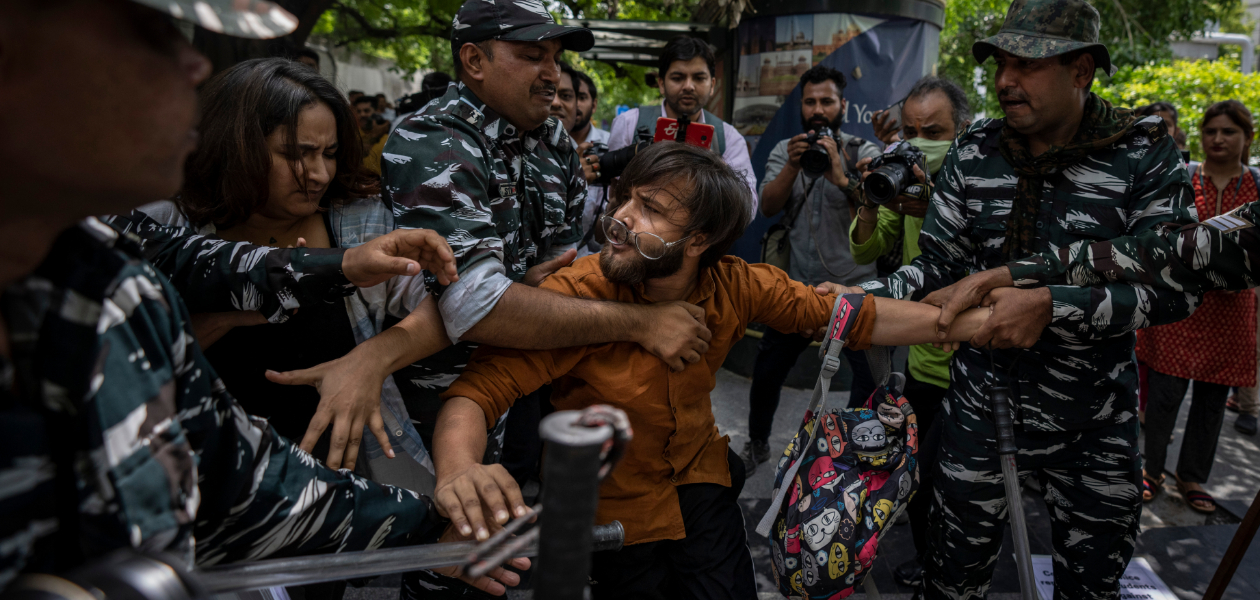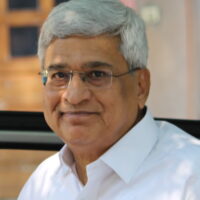
Until recently, when commemorating the significant anniversaries of independence, we could cite the parliamentary democratic system as one of the major achievements of independent India. The adoption of a republican constitution in 1950 provided the scope for people’s participation and a voice in politics which reflected the aspirations of the Indian people in their struggle for national independence.
Despite the narrow basis and the class constraints on the democratic system in a developing capitalist society, it was remarkable how parliamentary democracy could retain its vitality for over six decades. The prospect for democracy was sustained mainly due to the people and the popular struggles and democratic movements.
However, as we observe the 75th year of independence, the prospects for democracy are bleak and the parliamentary democratic system and all that the constitution provided for as the democratic underpinnings are endangered and under serious assault.
What we are witnessing today is the onset of full-fledged authoritarianism which is undermining all the norms of democracy and the institutions of the state, which maintain a set of checks and balances between the executive, the legislature, and the judiciary.

Full-fledged authoritarianism
Having come back to power with an increased majority in May 2019, the Bharatiya Janata Party (BJP) of Prime Minister Narendra Modi has set itself the goal of establishing a one-party dictatorship. This required an outright onslaught on the opposition.
All other parties in parliament are being sidelined; elected state governments of the opposition are destabilized by bribing of Members of the Legislative Assembly (MLA) and through the selective use of central government agencies against critics of Modi and the BJP.
The anti-corruption Enforcement Directorate (ED), the Central Bureau of Investigation, and the income tax department have been weaponized against opposition leaders and ministers in the opposition-ruled state governments.
As for the devaluation of parliament and the degrading of parliamentary procedures, they have become particularly virulent in the second term of the Modi government. The parliament sat for less than 50 days in 2021. Apart from a lack of discussion on legislation, there is hardly any scrutiny of legislative bills.
The 60 to 70% of bills that referred to the standing committees by the Parliament of India during the previous center-left United Progressive Alliance (UPA) government dropped to 22% in the first term of the Modi government and to just 13% in the second term.
This is compounded by the denial of the opposition’s right to raise issues and press for a vote during the legislative process. The status of the parliament has been downgraded, with various laws being declared “money bills” in order to bypass scrutiny and a vote in the upper house.
The authoritarian drive has also led to the trampling of the democratic rights and civil liberties of citizens which are enshrined in the constitution.
The criminalization of dissent and suppression of civil liberties are the hallmarks of an authoritarian regime. This has reached an unprecedented level through the use of draconian laws like the Unlawful Activities Prevention Act (UAPA) and the sedition clause.
Between 2014 and 2020, in a period of seven years, around 690 cases under UAPA were registered and 10,552 people were arrested under the provisions of the law. These include political activists, civil rights advocates, journalists, and writers. The Bhima Koregaon case, in which 16 prominent activists and intellectuals have been in jail for three years under the UAPA, is a prime example.
A characteristic feature of an authoritarian regime is when the judiciary ceases to act independently and stops keeping a check on executive excess. More and more, the Supreme Court has begun to behave like an executive court.
If we look back over the past 75 years, the biggest attack on democracy occurred with the imposition of “internal emergency” by Indira Gandhi in June 1975. That period of authoritarian rule saw the jailing of opposition leaders, suspension of civil liberties, and press censorship. But this existed for a limited period of 20 months, and the people rejected Gandhi’s Congress Party in the parliamentary elections that ensued.
The current ongoing assault on democracy is more serious and comprehensive. It seeks to change the nature of the republic by truncating democracy and undermining secularism and federalism.
Why is this vicious form of authoritarianism which stifles democracy taking hold in the country? This is not some aberration or accidental turning point, nor can it be ascribed to an individual’s dictatorial tendencies. We have to understand the conjuncture of forces which have spawned this authoritarianism.
Ambedkar’s warning
At the time of the adoption of the constitution, Dr. B.R. Ambedkar, who headed the committee that drafted the charter, warned that political democracy cannot succeed without social and economic democracy. He also warned that “Democracy in India is only a top-dressing on an Indian soil, which is essentially undemocratic.”
Over the decades, while “electoral democracy” thrived, the striving for economic and social democracy fell by the wayside. The capitalist path of development pursued by the ruling classes heightened class and regional inequalities. The advent of neoliberal policies, three decades ago, has resulted in sharply widening economic inequalities and the consolidation of plutocracy with obscene levels of wealth in their hands.
On the social side, the bourgeoisie which had compromised with landlordism and pre-capitalist relations made only formal attempts to end caste oppression and the iniquitous social order. Therefore, as Ambedkar presciently observed, the contradiction between political democracy and widening social and economic inequality has come to a head.

It is remarkable how this analysis of Ambedkar closely parallels that of the Marxists in India. The Communist Party of India (CPI-M) has, from the outset, held that the failure to undertake a thorough-going democratic transformation of social and agrarian relations would hamper the development of modern bourgeois-democratic society.
The onset of neoliberalism and the rise of Hindutva (Hindu nationalism) spelled the death knell of social and economic justice, which has resulted in curbing democracy and ushering in authoritarianism.
Neoliberalism restricts democracy
Neoliberalism narrows and restricts democracy by placing the market above the people and their rights. Big capital has invaded the political system, and all the bourgeois political parties have become subordinate to big money power. This is corroding the parliamentary system.
We must keep in mind what the CPI(M) program states: “The threat to the parliamentary system and to democracy comes not from the working people and the parties which represent their interests. The threat comes from the exploiting classes. It is they who undermine the parliamentary system both from within and without by making it an instrument to defend their narrow interests.”
The rise of the Hindutva forces and the assumption of power by the BJP with a majority in 2014 have brought about a qualitative shift in Indian politics.
State power is being wielded by a party which is imbued with the fascistic ideology of the Rashtriya Swayamsevak Sangh (RSS) [an Indian right-wing, Hindu nationalist, paramilitary volunteer organization.] They wish to institute a Hindu majoritarian rule which is inimical to democracy, as it denies minorities the equal status and rights as citizens.
We have seen both state-sponsored legislation and vigilante actions by Hindutva outfits on the ground which target Muslims and subject them to periodic bouts of violence and persecution by the state machinery.
In fact, in BJP-ruled states such as Uttar Pradesh, Madhya Pradesh, Gujarat, and Karnataka, minority populations have been virtually relegated to the status of second-class citizens.
Hindutva-corporate alliance
The authoritarian drive is, thus, fueled by the alliance forged between corporate elites and Hindutva forces. Both the necessity to push through neoliberal policies and impose Hindutva values on society requires a high degree of authoritarianism.
What is being undertaken is a reshaping of the institutions of the state, working within the facade of the constitution. The soil for authoritarianism is being cultivated not only in the political sphere but also in the social and cultural arenas.

The ban on cattle slaughter and beef consumption, moral policing, the denunciation of artists and cultural productions as anti-Hindu, the control of educational institutions making them conform to Hindutva values—all these are features of the authoritarian onslaught.
So democracy in India after 75 years of independence is at a crucial turning point.
The existence of the Hindutva authoritarian regime exemplified by the Modi government is a constant and potent threat to democracy and the democratic rights of the people.
The fight to defend democracy and democratic rights has to be waged in the coming days. But the struggle for democracy is linked to the struggle against Hindutva and neoliberalism.
For the working class, the fight for democracy is a vital one, the importance of which Rosa Luxemburg has lucidly spelled out: “If democracy has become partially superfluous and partially troublesome to the bourgeoisie, it is necessary and indispensable to the working class. It is necessary, first of all, because it creates the political forms (self-government, electoral rights, etc.) that will serve the proletariat as springboards and fulcrums in its transformation of bourgeois society. Second, however, it is indispensable because only in it, in the struggle for democracy, can the proletariat become conscious of its class interests and its historical tasks.”
The left, being the most consistent force against the neoliberal regime and Hindutva nationalism, has to play a crucial role in the mobilization of wider popular-democratic forces against the authoritarian danger.












Comments